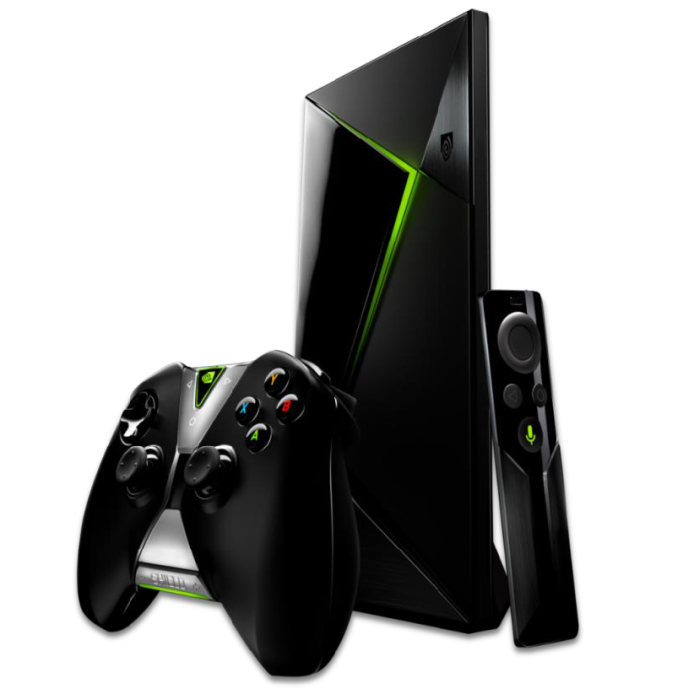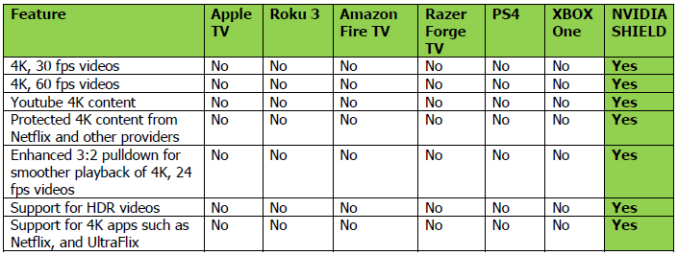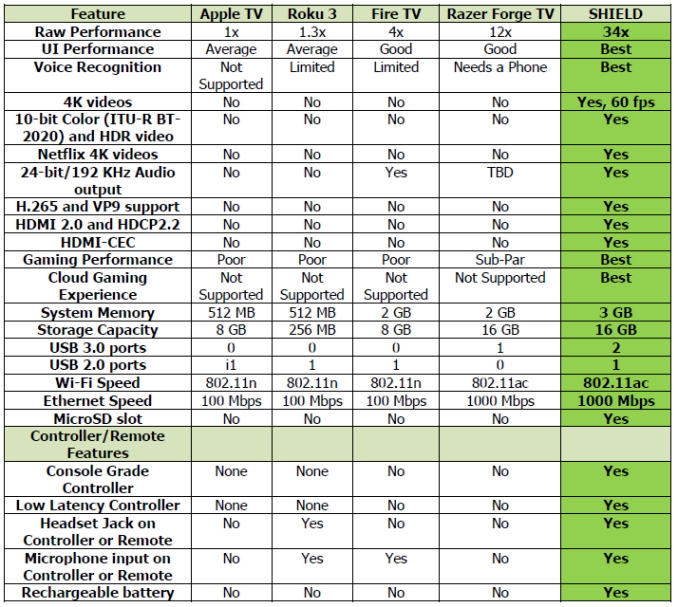The NVIDIA SHIELD Android TV Review: A Premium 4K Set Top Box
by Ganesh T S on May 28, 2015 3:00 PM EST- Posted in
- Media Streamer
- Home Theater
- TV
- 4K
- Shield
- NVIDIA

The battle for the living room (i.e, controlling the television experience) is heating up with forays from multiple vendors. As the cord-cutting trend gains momentum, the time seems to be right for disruption. Roku has been around for a long time and they continue to taste success with inexpensive and small over-the-top set-top boxes (OTT STBs). At the other end of the spectrum is the Apple TV, which, despite just being a 'hobby', has managed to move millions of units. Google had tried to make inroads into this market a few years back with the Google TV / Logitech Revue, but, it unfortunately didn't pan out as expected. Chromecast turned out to be more popular in their second attempt, but it was a limited play. In late 2014, Google launched Android TV along with the Nexus Player.
Coinciding with Google I/O, NVIDIA is releasing their previously announced SHIELD Android TV. First announed back in March at the 2015 Game Developers Conference, SHIELD Android TV is a premium 4K-capable over-the-top set-top box (OTT STB) with a powerful graphics engine. The differentiating aspects compared to the Intel Bay Trail-based Nexus Player and the Qualcomm Snapdragon-based Razer Forge TV lie in 4K support (HDMI 2.0 / HDCP 2.2 / Netflix 4K-certification) and excellent gaming credentials.
| NVIDIA SHIELD Family | ||
| NVIDIA SHIELD Tablet | NVIDIA SHIELD Android TV | |
| SoC | Tegra K1 (2.2 GHz 4x Cortex A15r3, Kepler 1 SMX GPU) | Tegra X1 (4x Cortex A57 + 4x Cortex A53, Maxwell 2 SMM GPU) |
| RAM | 2 GB LPDDR3-1866 | 3 GB LPDDR4-3200 |
| NAND | 16/32GB NAND + microSD | 16GB NAND + microSD + USB |
| Display | 8” 1920x1200 IPS LCD | N/A, HDMI 2.0 4Kp60 Output |
| Dimensions | 221 x 126 x 9.2mm, 390 grams | 210 x 130 x 25mm, 654 grams |
| Camera | 5MP rear camera, 1.4 µm pixels, 1/4" CMOS size. 5MP FFC | N/A |
| Battery | 5197 mAh, 3.8V chemistry (19.75 Whr) | N/A, 40W Power Adapter |
| OS | Android 5.0.1 | Android TV |
| Connectivity | 2x2 802.11a/b/g/n + BT 4.0, USB2.0, GPS/GLONASS, mini HDMI 1.4a | 2x2 802.11a/b/g/n/ac + BT 4.1/BLE, USB 3.0 + 2.0, HDMI 2.0 + HDCP 2.2, IR Receiver, Gigabit Ethernet |
| Launch Price | $299 (16GB/WiFi) + $59 (optional controller) | Basic: $199, Includes 1 SHIELD Controller Pro: $299, Adds 500GB Hard Drive |
The NVIDIA SHIELD smart TV platform comprises of three distinct products, the SHIELD console, the SHIELD wireless controller and the SHIELD remote.
The SHIELD is the main console, integrating a Tegra X1 SoC along with 3 GB of LPDDR4 DRAM and 16 GB of storage. I/O ports include two full-sized USB 3.0 host ports, a USB 2.0 micro-USB device port, GbE RJ-45 port, IR for universal remotes and 802.11ac 2x2 MIMO Wi-Fi with Bluetooth 2.1. It also includes a microSDXC slot. Video output is handled by a HDMI 2.0 port with HDCP 2.2 support.
The SHIELD Wireless Controller is the game controller bundled with the SHIELD console, and was first launched last year with the SHIELD Tablet. It uses Wi-Fi Direct for communication. A stereo headset jack and microphone are integrated. It also includes a rechargeable battery that can provide up to 40 hours of battery life.
Finally, the SHIELD Remote It is meant to be a replacement for the game controller in situations where single-handed operation is preferable. It uses Bluetooth for communication with the console. Like the game controller, a microphone and headset jack are included. The rechargeable battery is good for up to 4 weeks.
While the game controller and the console together retail in the basic package for $199, the SHIELD Remote is available separately for $50. Meanwhile after a slight snafu where it was announced back in April and then immediately pulled, NVIDIA is indeed offering a higher-end Pro SKU. SHIELD Pro model is similar to the SHIELD described above, except it adds an internal 500 GB hard drive into the mix and bundles a game - Borderlands: The Pre-Sequel! The Pro model is priced at $299.
Prior to diving into the details, let us take a look at the devices that NVIDIA is positioning the SHIELD Android TV against. Note that the two tables below are direct from NVIDIA's marketing material.
As we will see further down in the review, the above table is not far from the truth. In fact, except for NVIDIA claiming that their pulldown algorithm is enhanced compared to the competition, we tend to agree with everything. For the moment at least, NVIDIA pretty much has the 4K set top box to themselves.
NVIDIA claims a 34x raw performance increase compared to other OTT STB platforms. We won't endorse that particular number, but, in general, the performance of the SHIELD is miles ahead of the competition. The only other entry we find contentious is the availability of 24-bit / 192 KHz audio output. As we will see in the local media playback evaluation section, this is something of a moot point in most scenarios since the unit doesn't have licenses for decoding lossless HD audio. In any case, the above tables give an idea of where NVIDIA is positioning the SHIELD Android TV in the market.
The NVIDIA SHIELD Android TV also happens to be the first shipping product with the Tegra X1 SoC. We will first analyze the SoC and its performance in detail before moving on to Android TV in general and the SHIELD in particular.













167 Comments
View All Comments
Morawka - Thursday, May 28, 2015 - link
the chip and the wires (hdmi) have the necessary bandwidth, so shouldn't be a issue.Haydon987 - Thursday, May 28, 2015 - link
Shouldn't be in the case of dozens of currently existing devices, but in every case so far of any publicly available hardware I've seen, all encrypted content comes out 4:2:0 at 4k, so it would be nice for a vendor to acknowledge if it plays 4k hdcp 2.2 at 4:4:4 or just plays unencrypted stuff (like games, menus, ads, etc.) at 4:4:4 at 4k. Until a vendor specifically states it, I have my doubts. Sure all the features are listed to make it sound good to people who don't look too deeply into it, but they don't state when the features are interoperable.It's like a person listing for a spec sheet about themselves:
1. I can run 17 miles per hour
2. I can run 25 miles
This does not mean that this person can run 25 miles at 17 miles per hour. They are just 2 separately listed specs. Chances are they only maintain that speed for a few seconds.
In this case what is most likely:
1. I can play without color compression (4:4:4)
2. I can play protected content at 4k (hdcp 2.2), but I won't tell you if that is compressed or not.
ganeshts - Friday, May 29, 2015 - link
That is definitely an interesting question, but it is somewhat moot.. let me explain:Getting specs out of the way, the SHIELD does support RGB 4:4:4 at 4Kp60 on the HDMI port.
Now, all video content that consumers play back - Netflix or Blu-rays and the like - they are all encoded in 4:2:0 - In this case, the consumer has nothing to gain or lose whether the conversion to 4:4:4 is done on the source side or the sink side. So, HDCP 2.2 with just 4:2:0 support is fine.
On the other hand, for professional applications, where content is processed in 4:2:2 or even 4:4:4 format, it will be a problem - but, it is likely that the workflow process in that case doesn't involve protected content - the protection is applied / needed only on the consumer delivery side.
Again, this is an interesting aspect, and one that I will definitely be questioning HDMI source / sink vendors on. It is just that it doesn't matter for consumer applications.
457R4LDR34DKN07 - Thursday, May 28, 2015 - link
I'm interested in trying this with a hdhomerun prime with the live tv app. Does this android tv device support mpeg 2 decoding?457R4LDR34DKN07 - Thursday, May 28, 2015 - link
"The typical media library also includes TV programs that are interlaced MPEG-2 (for example). The SHIELD is currently not a good solution for such a case."Thanks, not for me then
Ryan Smith - Thursday, May 28, 2015 - link
The Live Channels app supports hardware MPEG-2 decoding, including deinterlacing. That functionality just isn't available to other media playback applications, since it was licensed for just the Live Channels app.DanCar - Thursday, May 28, 2015 - link
The recommendation row can be turned off partially or fully in settings -> System Preferences (3rd row) -> home screenYou can select which sources to enable and disable.
ganeshts - Saturday, May 30, 2015 - link
Somehow, I am not able to follow the path you are referring to..Under settings, I have Device > System, and under that nothing about Home Screen.. Do you have a video or set of screenshots showing the path?
I know that it is possible to go into the settings of a particular app and turn off the Notifications for that app - on Android TV, that turns off the 'Recommendations' - this is what I had done for the YouTube video showing the Android TV UI. The Recommendations row doesn't seem to have an option to turn it off completely..
BuddyRich - Thursday, May 28, 2015 - link
I was hoping they spent the money and licensed the codecs but no HD Audio or DTS (or MPEG2 or VC1) is a bummer. At least in the case of the video codecs the CPU is fast enough to decode in software. Will not replace my HTPC. Its funny they license them for their videocards, including their cheapest passive ones but not their premium set-top box. And the box doesn't even have to decode it, just pass it through to a receive, that shouldn't require a license at all.One thing that was unclear in your review though, if I use HDHomerun/Live TV app will it decode and deinterlace MPEG2 via hardware since the app is licensed? If so is this supported on Shield like it is on Nexus Player?
At least they shipped with working Netflix, unlike Razor.
webdoctors - Friday, May 29, 2015 - link
Why is a license needed if its just bit-streaming? If i connect it to my amp and my amp separates the hdmi video from the audio signals, why would the licensing matter on this box?